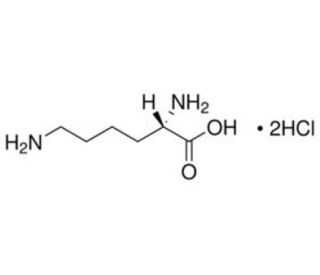

Molecular structure of L-Lysine dihydrochloride, CAS Number: 657-26-1
L-Lysine dihydrochloride (CAS 657-26-1)
Alternate Names:
(S)-2,6-Diaminohexanoic acid dihydrochloride
Application:
L-Lysine dihydrochloride is an essential proteinogenic α amino acid
CAS Number:
657-26-1
Purity:
≥98%
Molecular Weight:
219.11
Molecular Formula:
C6H14N2O2•2HCl
For Research Use Only. Not Intended for Diagnostic or Therapeutic Use.
* Refer to Certificate of Analysis for lot specific data.
QUICK LINKS
Ordering Information
Description
Technical Information
Safety Information
SDS & Certificate of Analysis
L-Lysine is an essential proteinogenic α amino acid used in a wide range of applications including as a supplement in cell culture media a substrate of enzymes such as L-lysine oxidase (EC 1.4.3.14) a component of poly-lysine polymers and a substrate for oxidation and glycation mechanism studies. In cell culture, it serves as a buffering agent and provides a nitrogen source necessary for optimal cell growth. Additionally, it is utilized in the synthesis of various compounds, including peptides and proteins.
L-Lysine dihydrochloride (CAS 657-26-1) References
- Bicarbonaturic effect of lysine in the dog. | Gougoux, A., et al. 1978. Kidney Int. 14: 215-27. PMID: 102863
- Reversible nephrotoxicity of onconase and effect of lysine pH on renal onconase uptake. | Vasandani, VM., et al. 1999. Cancer Chemother Pharmacol. 44: 164-9. PMID: 10412952
- Reversible configurational changes in poly-L-lysine hydrochloride induced by water. | BLOUT, ER. and LENORMANT, H. 1957. Nature. 179: 960-3. PMID: 13430748
- Long-term oral lysine supplementation in lysinuric protein intolerance. | Tanner, LM., et al. 2007. Metabolism. 56: 185-9. PMID: 17224331
- Biochemical characterisation of recombinant Streptomyces pristinaespiralis L-lysine cyclodeaminase. | Tsotsou, GE. and Barbirato, F. 2007. Biochimie. 89: 591-604. PMID: 17291665
- Comparative bioefficacy of lysine from L-lysine hydrochloride or L-lysine sulfate in basal diets containing graded levels of canola meal for female broiler chickens. | Ahmad, G., et al. 2007. Poult Sci. 86: 525-30. PMID: 17297165
- Optically active: microwave-assisted synthesis and characterization of L-lysine-derived poly (amide-imide)s. | Alborzi, AR., et al. 2011. Amino Acids. 41: 485-94. PMID: 20945152
- Low cytotoxic tissue adhesive based on oxidized dextran and epsilon-poly-L-lysine. | Hyon, SH., et al. 2014. J Biomed Mater Res A. 102: 2511-20. PMID: 23996972
- Arginine and lysine reduce the high viscosity of serum albumin solutions for pharmaceutical injection. | Inoue, N., et al. 2014. J Biosci Bioeng. 117: 539-43. PMID: 24268865
- Specificity of Lysine for the Growth of the Turkey Poults and the Prevention of Feather Depigmentation | Vohra Pran, Kratzer F.H. 1959. Poultry Science. 38: 280-281.
- Optically active poly(hydroxyurethane)s derived from cyclic carbonate and L-lysine derivatives | Nobuhiro Kihara, Yuuji Kushida, Takeshi Endo. 1996. Journal of Polymer Science Part A: Polymer Chemistry. 34: 2173-2179.
- Controlling Polymer Architecture in the Thermal Hyperbranched Polymerization of l-Lysine | Markus Scholl, Tuan Q. Nguyen, Bernd Bruchmann, and Harm-Anton Klok. 2007. Macromolecules. 40: 5726–5734.
- Ways of selective polycondensation of L-lysine towards linear α- and ε-poly-L-lysine | Chau Hon Ho, Erich Odermatt, Ingo Berndt, Joerg C. Tiller. 2008. Journal of Polymer Science Part A: Polymer Chemistry. 46: 5053-5063.
- Preparation and antibacterial activity of a cellulose-based Schiff base derived from dialdehyde cellulose and L-lysine | Liming Zhang a, Pengchao Yan a, Yan Li a, Xihong He b, Yujie Dai b, Zhilei Tan a. 2020. Industrial Crops and Products. 145.
Substrate of:
Enzyme.Ordering Information
| Product Name | Catalog # | UNIT | Price | Qty | FAVORITES | |
L-Lysine dihydrochloride, 25 g | sc-279252 | 25 g | $45.00 |
